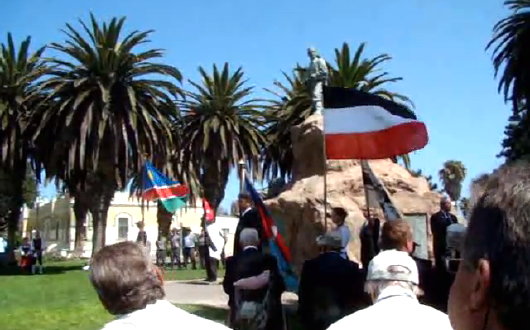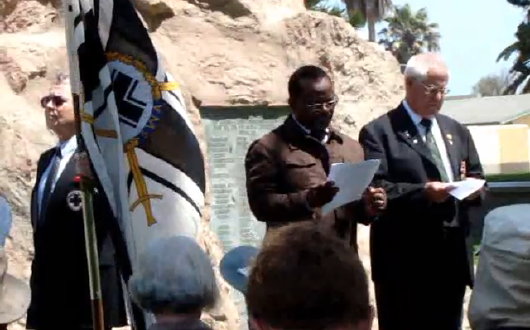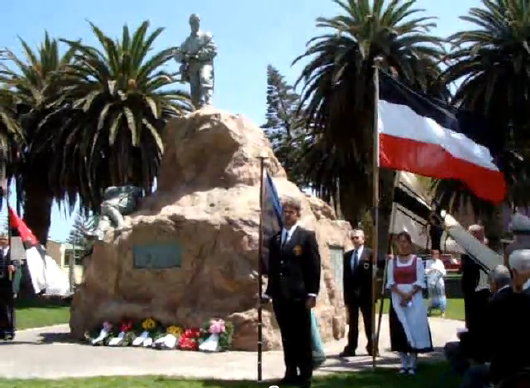
About Andrew Cusack
 Writer, web designer, etc.; born in New York; educated in Argentina, Scotland, and South Africa; now based in London.
Writer, web designer, etc.; born in New York; educated in Argentina, Scotland, and South Africa; now based in London. read more
News
Blogs
Reviews & Periodicals
Arts & Design
World
France
Mitteleuropa
Knickerbockers
Argentina
The Levant
Africa
Cape of Good Hope
Netherlands
Scandinavia
Québec
India
Muscovy
Germany
Academica
The Namibian Way of Reconciliation
Accepting differences, not erasing them, is the path to civic harmony

DISCORDIA GERANT ALII, tu felix Namibia reconciliant! Peace and reconciliation are amongst the noblest of earthly aims, but the deluded establishment that rules most of what used to be called the Western world often seem convinced that peace among peoples can only be achieved by erasing the differences between them. Yet it is precisely those differences — the unique characteristics of tribe, clan, and platoon that separate us from some and unite us with others — that make us who we are: human beings, created by God in time and place and circumstance. Without them, we are rootless citizens of nowhere, easily abused and manipulated by the powerful. (How flimsy is even the thickest oak when its roots have been severed). It is the acknowledgement of differences, rather than the erasing of them, that leads to true respect and understanding between and among peoples. While the racial grievance industry thrives in America and Europe, an entirely different attitude exists in happy Namibia.
A case in point: the events surrounding the German quashing of the Herero uprising in German South-West Africa (now Namibia) in 1904–1907 are often considered the first instance of genocide in the twentieth century. While the circumstances were greatly exaggerated for British propaganda purposes during the Great War, the historical evidence suggests the Germans were responsible (directly and indirectly) for the slaughter and deaths of many more native Herero and Namaqua tribesmen than can possibly be justified by the colonial authority’s responsibility for keeping order in the land.
One hero of the rebellion’s suppression was German officer Victor Franke, who defeated a Herero force vastly superior in numbers at Omaruru in 1904. Four years later, out of respect and admiration for the man, a round stone tower was erected at Omaruru and dedicated to Franke. In 2008, the Franke Tower was restored and rededicated with great solemnity. The old Schwarz-Weiß-Rot flag of the German Empire and the blue-red-green of Namibia flew side-by-side for a ceremony in which Namibians both of the German tribe and of the Herero tribe came together in a spirit of mutual respect and reconciliation.
“The 88-year-old Irma Stenger, daughter of a former Schutztruppe sits peaceably alongside her friend, the wife of a Herero chief,” reports the Allgemeine Zeitung, Namibia’s eldest daily. “Nothing seems to stand between them, and together they sit in the sun.”
The mayor of Omaruru, a Herero himself, rises to say a few words, and stakes claim to the stately monument for Namibians of every tribe: “The Franke Tower is a heritage of all Namibians. A landmark for the whole country.”
“That was a good speech,” the elder German says. “We should all live in peace.”
“The children of German and Herero have to come together,” agrees the chief’s wife, dressed in the quasi-Victorian garb of Herero tradition. “The time of the war is over.”

A similar ceremony takes place every year at the German Navy Memorial in sunny Swakopmund on the Atlantic coast. The Governor of Erongo (above) attends and thanks the Traditionsverband for organising this commemoration in which the living show their respect for the dead. Tribe addressing tribe as friends, neighbours, fellow countrymen — as real people, not as make-believe “citizens of the world”.
Though sparsely populated, Namibia is a land of many peoples: Ovambo, Kavango, Herero, Damara, Coloured, Baster, German, Afrikaner, Portuguese, Nama, and so on and so forth. And, while it’s as beautiful as a paradise, Namibia is no utopia — like any other land it has its fair share of problems and struggles. But, trite as it may sound, Namibia is a free country where different peoples have managed to come to some type of respectful accord with each other while maintain the peculiarities of their difference.
My old Latin teacher in high school suggested the existence of an international conspiracy of “monotony monitors” who patrol the world ensuring that anything interesting, peculiar, or just plain different would eventually be levelled and destroyed. Wouldn’t it be a shame if we, the vive la différence crowd, surrendered the noble task of peace and reconciliation to the monotony monitors? If we don’t strive to enjoy the peace of peculiarity, we will be guaranteed suffer the peace of banality.

Search
Instagram: @andcusack
Click here for my Instagram photos.Most Recent Posts
- Patrick in Parliament March 18, 2024
- Articles of Note: 13 March 2024 March 13, 2024
- Cambridge March 9, 2024
- Taken on Trust March 4, 2024
- Immanuel on the Green March 2, 2024
Most Recent Comments
Book Wishlist
Monthly Archives
Categories



“…the chief’s wife, dressed in the quasi-Victorian garb of Herero tradition…” Now that fascinates me, I wish you had a picture of it!
Wonderful article, and I think the people of Namibia are very wise. We can never ask people to get rid of their different characteristics without making them characterless nobodies. I’m reminded of my first reaction to John Lennon’s utopia “Imagine” in which all will get along as one because they will have nothing that could divide them. My reaction was imagining what a boring aimless, rootless bunch we would be reduced to. How empty life would be with no religion, no countries, etc..